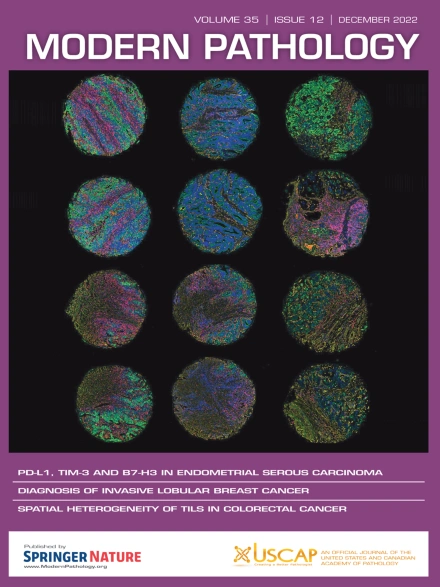晚期结肠癌患者瘤内纤维化特征与淋巴结转移和复发相关。
IF 7.1
1区 医学
Q1 PATHOLOGY
引用次数: 0
摘要
纤维化是晚期结肠腺癌的重要病理特征。然而,对结肠癌纤维化特征的客观和系统评估仍未得到充分探索。本研究评估了反映淋巴结转移和预测复发的肿瘤内纤维化的表型组织学特征,以确定晚期结肠腺癌患者的纤维化特征。在499例手术切除的结直肠癌患者中,通过倾向评分匹配选择39例T3期结肠腺癌。石蜡包埋组织进行Azan-Mallory染色,转化为数字病理图像。使用FibroNest定量数字病理平台,根据原发肿瘤的胶原含量和结构对纤维化的组织学表型进行量化。定量纤维化特征(qFTs)描述了连续组之间的大部分变异性,并被整合到表型纤维化综合评分(Ph-FCS)中。总体而言,Ph-FCS包括胶原含量、纤维形态和纤维结构,在T3结肠癌伴淋巴结转移组和非转移组之间存在显著差异,区分转移组和非转移组的敏感性为89.5%,特异性为89.4% (AUC 0.95)。在所有参数中,峰度是两组之间差异最显著的个体因素。峰度是一种纹理分析成分,表示直方图数据的浓度。此外,在19例淋巴结转移患者中,Ph-FCS能够区分化疗后复发组和非复发组,敏感性为71.4%,特异性为100% (AUC 0.88)。详细分析显示,与非复发组相比,复发组的纤维分支数量明显增加。综上所述,在接受结肠手术的晚期结肠癌患者中,有无淋巴结转移的患者以及化疗后有无复发的患者的纤维化组织学表型存在显著差异。非肿瘤病变中胶原蛋白的表型分析可能是预测预后的有效方法。本文章由计算机程序翻译,如有差异,请以英文原文为准。
Intratumoral Fibrotic Features Are Associated With Lymph Node Metastasis and Recurrence in Patients With Advanced Colon Cancer
Fibrosis is a significant pathological feature of advanced colon adenocarcinomas. However, objective and systematic assessments of fibrosis signatures in colon cancer remain underexplored. This study evaluated the phenotypic histologic features of fibrosis within the tumor, which reflect lymph node (LN) metastasis and predict recurrence, to identify fibrosis signatures in patients with advanced colon adenocarcinoma. Of 499 patients who underwent surgical resection for colorectal cancer, 38 patients with stage T3 colon adenocarcinoma were selected by propensity score matching. Paraffin-embedded tissues were stained with Azan-Mallory and converted to digital pathological images. The histologic phenotypes of fibrosis were quantified based on collagen content and structure in primary tumors using the FibroNest quantitative digital pathology platform. Quantitative fibrosis traits, describing most of the variability between consecutive groups, were integrated into a phenotypic fibrosis composite score (Ph-FCS). Overall, Ph-FCS, which encompasses collagen content, fiber morphology, and fiber structure, differed significantly between the T3 colon cancer with LN metastasis and nonmetastasis groups, distinguishing between the metastasis and nonmetastasis groups with 89.5% sensitivity and 89.5% specificity (area under the curve, 0.95). Among all the parameters, kurtosis, a texture analysis component indicating the concentration of histogram data, was the most significantly different individual factor between the 2 groups. Furthermore, among the 19 patients with LN metastasis, Ph-FCS could distinguish between the recurrence and nonrecurrence groups after chemotherapy with 71.4% sensitivity and 100% specificity (area under the curve, 0.88). Detailed analysis revealed that the number of fiber branches was significantly higher in the recurrence group compared with the nonrecurrence group. In conclusion, among patients with advanced colon cancer who underwent colon surgery, the fibrotic histologic phenotype differed significantly between those with and without LN metastasis, as well as between patients with and without recurrence following chemotherapy. Phenotypic analysis of collagen in nontumor lesions may be an effective method for predicting outcomes.
求助全文
通过发布文献求助,成功后即可免费获取论文全文。
去求助
来源期刊

Modern Pathology
医学-病理学
CiteScore
14.30
自引率
2.70%
发文量
174
审稿时长
18 days
期刊介绍:
Modern Pathology, an international journal under the ownership of The United States & Canadian Academy of Pathology (USCAP), serves as an authoritative platform for publishing top-tier clinical and translational research studies in pathology.
Original manuscripts are the primary focus of Modern Pathology, complemented by impactful editorials, reviews, and practice guidelines covering all facets of precision diagnostics in human pathology. The journal's scope includes advancements in molecular diagnostics and genomic classifications of diseases, breakthroughs in immune-oncology, computational science, applied bioinformatics, and digital pathology.
 求助内容:
求助内容: 应助结果提醒方式:
应助结果提醒方式:


